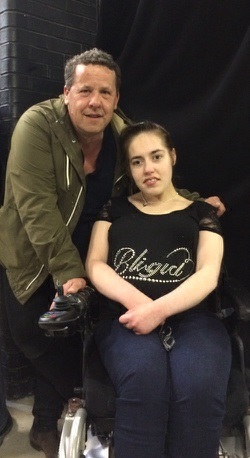Flying Disabled’s Chris Wood Seeks to Facilitate PaxEx for Wheelchair Users
Share

APEX Insight: A first-of-it- kind symposium will take place at Virgin Atlantic’s UK headquarters near Gatwick Airport in September. Hosted by Flying Disabled founder Chris Wood, the event will encourage airlines, manufacturers, regulators, the accessibility community and governmental departments to help facilitate the in-flight experience for wheelchair users.

Image via Chris Wood
Wheelchairs cannot enter the aircraft cabin – at least that’s the case in the UK. For Chris Wood, who lives on the outskirts of London and is a single parent to son Jordan and daughter Tayla – both of whom are disabled – an unhappy flight with his daughter to Mexico was the catalyst for a mission to bring about a better in-flight experience for wheelchair users.
Tayla is one of 2.7 million disabled people who receive assistance from UK airports each year, according to the Civil Aviation Authority in its most recent analysis of accessible air travel.
Wood says that, since wheelchairs are often custom designed to fulfill specific medical requirements and can cost well into five figures, “one of the biggest fears of disabled travelers is arriving at the destination with their wheelchair broken, lost or destroyed.” UK-based disabled children’s charity Whizz Kidz published a survey entitled “Get on Board“, looking at transport issues for disabled young travelers and 75% of respondents raised concerns that their wheelchairs would be damaged during the journey.
The survey also highlighted that while on board, 71% per cent said that in the past, they’d been unable to use toilets while airborne, and 62% said there wasn’t always an aisle wheelchair available to allow them to move around the aircraft. More worryingly, 47% of wheelchair users said they were “not confident about being transferred to their seat in a safe and dignified manner”.
Eighteen months ago, Wood founded Flying Disabled, a campaign to enable disabled travelers to bring their own wheelchair on board and fly seated in it. In the US, the idea of at least exploring the possibility of allowing wheelchair users to bring and use their wheelchairs onboard is one of the objectives of the Air Carrier Access Amendments Act of 2017, a Bill brought by Senator Tammy Baldwin, which is in its early stages. Section 8 calls for the development of an “Airline Passengers with Disabilities Bill of Rights” which would “describe the basic rights and responsibilities of air carriers, their employees and contractors, and people with disabilities. But the bit that really mirrors Wood’s campaign is Section 9, which requires that a “Study on in-cabin wheelchair restraint systems” be implemented within 2 years of the enactment of the Act.
“One of the biggest fears of disabled travelers is arriving at the destination with their wheelchair broken, lost or destroyed.” – Chris Wood
On both sides of the Atlantic, there are significant hurdles ahead: The solution must be dignified, address (as yet undefined) airworthiness requirements, fulfill medical functionality criteria, be commercially viable for manufacturers and be affordable for users. Then, the complex operational considerations of the airlines and aircraft manufacturers must also be factored in.
Most of these parameters are undefined or unknown, but Wood told APEX Media that he has the support of Virgin Atlantic. Wood will host the inaugural “Wheelchair in the Cabin Symposium” on September 22 at Virgin Atlantic’s UK headquarters in Crawley, next to Gatwick Airport. Wood says that “there will be key speakers and delegates from major industry players including airlines, regulators, seating manufacturers, the accessibility community and governmental departments”. For more information, contact chris.wood@flyingdisabled.org.uk.


